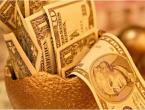Weekly foreign exchange review: oil prices soared + beautiful jobs, Canadian dollar hit a two-month high; risk aversion cooled, yen hit a year and a half low
In the past week, the U.S. dollar remained at a high level and fluctuated, and the euro against the U.S. dollar fluctuated downward. However, the Canadian dollar and the Japanese yen fluctuated greatly. Because of the surge in international oil prices and the beautiful performance of Canadian employment data, the Canadian dollar hit a record for nearly two months. New highs, and a variety of news this week increased risk-taking sentiment, suppressing the performance of the safe-haven yen, the dollar rose to a year and a half high against the yen.
International oil prices have soared, employment data is beautiful, and Canadian dollars are favored by the market
In the past week, international oil prices have risen sharply. U.S. crude oil once broke through the 80 mark and hit a seven-year high to $80.11 per barrel. Brent crude oil rose by more than 5% this week, hitting a three-year high of $83.47 per barrel. . This provides the Canadian dollar with upward momentum, because Canada’s economy relies on crude oil exports, and rising oil prices boosted Canada’s economic growth expectations.
In addition, Canada’s September employment data released this week also performed beautifully. The employment rate fell from 7.1% to 6.9%, a record low in 18 months. The number of new jobs reached 157,000, nearly three times the expected value. The 3 million jobs lost during the COVID-19 pandemic have all recovered, boosting the market’s expectations of an early interest rate hike in Canada and providing strong upward momentum for the Canadian dollar.
The U.S. dollar fell 1.39% against the Canadian dollar this week, hitting a minimum of 1.2452, the lowest since August 2, closing at 1.2472, both lower than the 100-day moving average of 1.2483 and the 200-day moving average of 1.2514, which hit the bullish confidence in the US dollar against the Canadian dollar. , The market outlook may further test the strong support near the July low of 1.2423.
The yield on the 2-year Canadian Treasury bond soared after the release of the Canadian Employment Report, and the difference from the yield on the 2-year U.S. Treasury bond widened to 37 basis points, the highest since January 2015
Monex's Simon Harvey said that the employment data confirms the expectation that the Bank of Canada will decide to downsize at its October meeting.
Andrew Kelvin, chief analyst of Canadian Securities, pointed out that we are very pleased to see that our employment participation rate has increased substantially, and the unemployment rate has also fallen at the same time. "The Bank of Canada will still want to see more, because they not only want to see the number of employed people return to their pre-epidemic situation, but also want to see the proportion of employed population also return to pre-epidemic. Therefore, they want to see more Employment growth, so that we can see the employment trend. The current data is encouraging, especially when compared to the weak situation at the beginning of the third quarter. This is a sign that the economy continues to recover."
The National Bank of Canada Wealth Management pointed out that in view of rising commodity prices, the United States and Canada will fall to 1.20 in 2022. "Given that energy prices will not fall sharply in the next few months, we believe that the United States and Canada should fall. The recent performance of the Canadian labor market, as well as the positive outlook for commodity prices and nominal GDP, we continue to expect the Bank of Canada to reduce quantification again in October. The scale of easing. We have raised our forecasts for oil and gas prices, and we now expect the United States and Canada to fall to 1.20 in 2022."
Bet on the Bank of England to raise interest rates, the euro’s worst weekly performance against the pound in five months
The euro fluctuated and weakened against the pound this week. It once fell to 0.7474, the lowest level since August 13, and closed at 0.8498, with a weekly decline of 0.7%, the biggest weekly decline since May. The expected interest rate hike offsets the fuel crisis in the UK. And concerns about labor shortages after Brexit.
The British pound against the euro hit a two-month low in September and erased all the strong gains in 2021 against the U.S. dollar. The shortage of labor has caused the UK's supply chain to become extremely tense.
But expectations that the Bank of England may take early action to solve the inflation problem continue to rise, supporting the pound this week.
The pound rose 0.51% against the dollar this week, closing the gains for the first time in five weeks, closing at 1.3615.
ING told clients in a report that the core theme of the market is the reaction of central bank officials to expectations of rising inflation. "In the UK, the market clearly believes that the Bank of England will be forced to act sooner than policymakers have suggested."
Due to market expectations, the Bank of England is about to raise interest rates for the first time after the epidemic, and the yield on British two-year government bonds hit the highest level since February 2020 on Friday.
The British Recruitment and Employment Federation (REC) survey shows that the starting salary increase offered by British employers to new employees is at least the largest since the 1990s.
New Zealand raises interest rates for the first time in seven years, but the New Zealand dollar is rejected
The Federal Reserve Bank of New Zealand raised interest rates for the first time in seven years on October 6, and said it would further tighten its policies, hoping to cool the domestic economy and the booming real estate market. However, the New Zealand dollar fluctuated and weakened after the interest rate hike. It once fell to 0.6877. The rate hike by the country's central bank proved to be an anticlimax, and finally closed at 0.6939, with a weekly decline of 0.13%.
The 25 basis point increase in interest rates marked the beginning of the tightening cycle, which was originally expected to begin in August, but due to the outbreak of the Delta new crown variant strain and the continued lockdown of the largest city, Auckland, the interest rate hike was postponed.
When announcing its policy decision, the Federal Reserve Bank of New Zealand stated, “The Committee pointed out that over time, it is expected that further monetary policy stimulus measures will be cancelled, and future measures will depend on the medium-term prospects of inflation and employment.”
The New Zealand Fed’s 25 basis point rate hike and familiar hawkish tone have little support for the local currency exchange rate, although the central bank is expected to raise interest rates further in November and next February.
Jason Wong, senior market strategist at BNZ in Wellington, said: "We are moving in the direction of a series of interest rate hikes, and market prices have largely reflected this."
He said that for the New Zealand dollar, this means "the U.S. dollar becomes dominant." "This has something to do with the Federal Reserve, but from a global perspective, China's situation and European energy tensions will have an impact, and will make the market tense, which strengthens the support for the US dollar."
The Federal Reserve Bank of New Zealand's statement mentioned that it expects to take further actions over time, but it also acknowledges that the epidemic will have a long-term impact on economic activities.
Jarrod Kerr, chief economist at Kiwibank, believes that the New Zealand dollar is undervalued given the prospects for strong global commodity prices and local interest rates. The Reserve Bank of New Zealand may be one year earlier than the Federal Reserve, and may be two years earlier than the Reserve Bank of Australia. The widening spread is beneficial to New Zealand, and the New Zealand dollar may rise further to $0.7500 by the end of the year. "
Multiple signs have increased risk appetite, and the safe-haven yen has been abandoned
This week coincides with China's National Day holiday. Although there are occasional cases in the country, it still can't stop the public's enthusiasm for travel. According to data from the Ministry of Culture and Tourism of China, on the 7th of the National Day, 515 million domestic tourists traveled nationwide, a year-on-year decrease of 1.5% on a comparable basis, and a return to 70.1% of the same period before the epidemic on a comparable basis.
Caixin China's September service industry and comprehensive PMI announced on Friday both returned to the boom range, thanks to the recovery of new business volume and output of China's service industry, and the growth rate was strong.
International relations are also showing signs of recovery.
On October 8, Foreign Ministry Spokesperson Zhao Lijian introduced that in accordance with the spirit of the call between the two heads of state on September 10, Yang Jiechi, member of the Political Bureau of the CPC Central Committee and Director of the Office of the Central Foreign Affairs Commission, met with Sullivan, National Security Affairs Assistant to the President of the United States, in Zurich, Switzerland. . The two sides exchanged comprehensive, candid and in-depth views on Sino-US relations and international and regional issues of common concern. During the call, the two heads of state agreed to continue to maintain regular contact through various means. In order to implement the consensus of the two heads of state on the phone call, Yang Jiechi and Sullivan discussed holding a video meeting between the two heads of state before the end of the year.
On the morning of October 9, Liu He, member of the Political Bureau of the CPC Central Committee, Vice Premier of the State Council, and the Chinese leader of the China-US Comprehensive Economic Dialogue, held a video call with Dai Qi, the US trade representative. The two sides had a pragmatic, candid and constructive exchange and discussed three aspects.
Rodrigo Catril, senior foreign exchange strategist at National Australia Bank (NAB), wrote in the report that “improved risk appetite favors currencies with economic growth themes, while safe-haven currencies perform poorly.”
In addition, the bipartisan leaders of the U.S. Senate reached a consensus on temporarily raising the debt ceiling, which seems to have temporarily escaped the federal government from a debt default for the first time in history.
All the above news has increased the risk appetite of the market, and has significantly suppressed the safe-haven yen. The dollar against the yen this week hit 112.25, the highest since the end of April 2019, closing at 112.24, a weekly increase of 1.07%, the fifth consecutive week. The rise is also the biggest weekly gain in the past six months.
Other currencies
The U.S. dollar index oscillated this week, with a weekly increase of only 0.07% to close at 94.13. On the one hand, the US non-agricultural employment data fell short of expectations for the second consecutive month, dragging down the performance of the U.S. dollar, but traders believe that this may not affect the Fed’s code reduction time. Table, the US dollar is still well supported.
The euro fluctuated slightly against the US dollar this week. The lowest hit 1.1529, a 14-month low, and closed at 1.1569. The weekly decline was about 0.23%, which was the fifth consecutive week of decline. The relative strength of the US dollar was suppressed against the euro. In addition, Natural gas prices in Europe have jumped to record highs, and traders are worried that the risk of stagflation is spreading.
(Daily chart of the euro against the dollar)
The Australian dollar rose slightly against the US dollar this week, supported by risk appetite, reaching a maximum of 0.7338 and closing at 0.7309, a weekly increase of about 0.7%.
Prospects
The next week will usher in a "super week". In terms of data, China's CPI, PPI data and import and export data will be ushered in. The United States will announce heavy economic data such as CPI, PPI, and retail sales. In terms of risk events, OPEC, EIA and IEA will all publish monthly reports on the crude oil market. Several Fed vote committee and ECB officials will speak. In addition, the Fed will also announce the minutes of the September monetary policy meeting.











